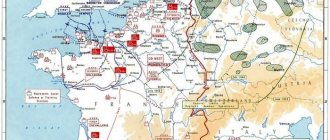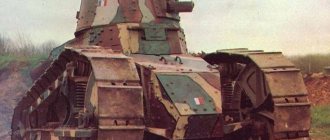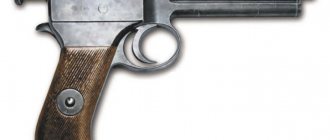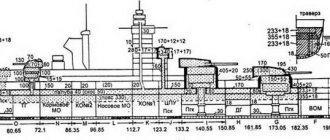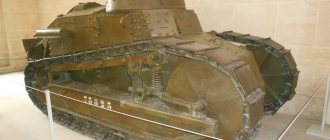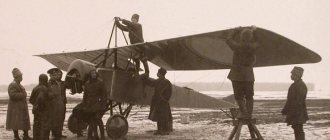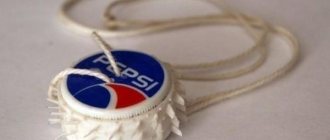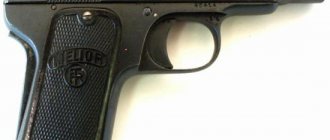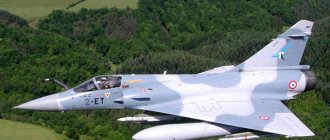Airplanes of France during World War II
| Fighters | Bombers and attack aircraft |
| Aircraft of the battlefield | Float planes |
| flying boats | Transport aircraft |
| Educational and training |
On September 1, 1939, Germany attacked Poland (which was captured by September 17), starting World War II. On September 3, England and France declared war on Germany, carrying out very cautious military actions against the Germans - the few bombing raids their military aircraft carried out met with failure, and many efforts were ineffective. Italy entered World War II on June 10, 1940, declaring war on France, but it [France] had already capitulated on June 22.
Black Day of France
During the Great Patriotic War, the allies of the USSR fought not only on the “second front”, but also directly shoulder to shoulder with Soviet soldiers.
During the war, several national units were formed on the territory of the Soviet Union to fight the Nazis on the Soviet-German front. One of the most famous national military units formed in the USSR was the French Normandy squadron, which later turned into the Normandy-Niemen regiment.
June 22, 1940 was a dark day for France. On this day, a truce was signed in the Compiegne Forest, which actually meant the defeat of France in World War II.
According to the terms of the armistice, 60 percent of French territory, including the entire Atlantic coast and the capital of the country, Paris, was in the zone of German occupation. The French army had to disarm and hand over heavy weapons to the German forces; The French navy was to be demobilized and placed in ports under the supervision of the occupation forces. France was entrusted with the responsibility of maintaining German troops on its territory.
All German prisoners of war captured by France were handed over to Germany, and French prisoners of war were to remain in the camps until the end of World War II.
To further humiliate the defeated enemy, Hitler of Marshal Foch , specially delivered for this purpose - that is, exactly in the same place and in exactly the same way as during the surrender of Germany in the First World War.
In return for this humiliation, France received formal independence in the remaining 40 percent of its territory. However, the French government operated there too, virtually completely dependent on the will of Hitler.
Military aviation of France before the start of World War II
Even during the First World War, France adhered to the “bomber idea”, which continued to persist in the 20s and 30s. But French aircraft were increasingly becoming conceptually outdated, and rearmament at the end of the thirties did not bring significant results. In the mid-30s, the Minister of Air Force Pierre Cote decided not to leave the production of combat aircraft under the control of private firms. In the summer of 1936, the French Government began to nationalize aircraft manufacturing companies (except for the aircraft engine industry) to create six large regional entities. Only at the end of the 1930s did France begin producing high-speed bombers such as the Liore et Olivier LeO 451, which in 1939 were the fastest bombers in the world.
The desire to create more than 2,500 modern combat aircraft was justified by the Air Force commander's statement that only less than half of the 1,400 military aircraft, many of which were obsolete, could take part in combat operations. France, being on the threshold of war, tried to respond to the threat through an intensive modernization program in 1938-1939. But this turned out to be not enough, and besides, it was too late. By the beginning of World War II, the French Air Force, according to some sources, was equipped with only 826 fighters and 250 bombers, some of which were not combat-ready for various reasons.
Thus, the state of the French Air Force by the summer of 1939 was not successful. All efforts to modernize military aircraft have proven ineffective. The combat value of some fighters tended to zero, and their inability to withstand the Messerschmitts of the Luftwaffe was no secret. The most popular fighter of the French Air Force at that time, the MS.406C1, was significantly inferior in flight characteristics to the German Messerschmitt Bf.109. However, it should be noted that in the last pre-war month the French aircraft industry made a significant breakthrough. The number of Morane-Saulnier MS.406C1 fighters was increased to 573 units by September 1, 1939, and the production rate was 11 aircraft per day. But by the spring of 1940, the MS.406C1 was considered obsolete, and its production was stopped, while the already built vehicles were being upgraded to the level of the MS.406C1. On the eve (and during) World War II - 1938-1940. — five types of single-engine fighters were introduced into production:
- Morane-Saulnier MS.406
- Marcel Bloch MB. 151/152
- Dewoitine D.520
- Caudron C.714 Cyclone
- Arsenal VG-30 (33)
- Potez 630/631
On May 11, about 20 French bombers and over 30 British escort fighters were shot down, trying to disrupt the crossing of German troops across the Meuse River. And this was all just the beginning, as the French fighter and bomber fleet dwindled rapidly throughout May as Luftwaffe fighters and anti-aircraft guns destroyed more and more warplanes. Squadrons sometimes lacked any contact with army units, but they needed to be supported. There are also such figures: during the Battle of France, the Germans lost more than 850 aircraft, and the French - over 750.
Free France is rushing to the East
Not all French were ready to accept the shame. General Charles de Gaulle created the Free France movement, which opposed the Nazis and French collaborators and sought to restore French independence.
De Gaulle (center) in Tunisia, 1943. Photo: Commons.wikimedia.org
As part of the Free French, the French military, who did not want to accept defeat, formed the Free French Forces. Their core at the first stage consisted of 1,300 people from the expeditionary force in Norway and the French Legion.
The Free French Forces fought alongside the British against Italian-German forces in North Africa and the Middle East.
But de Gaulle understood perfectly well where the main battle with the Nazis was taking place, where the fate of France was being decided.
In March 1942, the Free France committee, renamed Fighting France, turned to the authorities of the Soviet Union with an official proposal to send a group of pilots and aircraft mechanics to the USSR to participate in combat operations against Nazi Germany. Negotiations about this had been conducted before; moreover, General de Gaulle spoke out in favor of having not only French pilots, but also a French infantry division appear on the Soviet-German front.
The idea of a French division on the Soviet-German front was not realized, but on November 25, 1942, a Soviet-French agreement was signed on the formation of a French aviation squadron on the territory of the USSR.
French aviation industry in the service of the Luftwaffe
Home » Real story » History of Wars » French aviation industry in the service of the Luftwaffe
History of WarBooks on the history of aviation
Parafin 03/18/2012 941
0
in Favoritesin Favoritesfrom Favorites 0
From time to time on the site (and not only) in various topics and comments, the question arises about the participation of occupied Europe in the production of military equipment for Nazi Germany. Just recently, data about “3000 aircraft” produced by French factories for the Luftwaffe again surfaced. On the other hand, it is not clear what kind of machines these are, when they were built, by whom exactly, and whether it is true that there are exactly 3000 of them. So I decided to deal with this issue.
The French aviation industry was going through hard times before the 1939 war: the “prototype policy” and a chronic lack of money led to significant obsolescence of the Armée de l'Air aircraft fleet. On the other hand, the nationalization of aircraft manufacturing enterprises ensured the consolidation of existing capacities, made it possible to centralize management and made it possible to organize the efficient distribution of resources. By the summer of 1940, the French Air Force was receiving up to 400 aircraft per month. And this product was not lost in vain - in France, the Luftwaffe suffered huge losses (2073 aircraft in 42 days - about 50% of the original strength), which played a significant role in the loss of the Battle of England.
After the defeat of 1940, the main centers of French aircraft manufacturing (primarily Paris and its suburbs) found themselves in the zone of German occupation. Of the large enterprises, only the assembly shops of Toulouse (the SNCAM association) were at Vichy's disposal. The main manufacturers of aircraft engines also came under German control: Gnome-Rhône and Hispano-Suiza. How did the Germans use the opportunities they received? What cars did they manage to put into production?
Of the variety of quite successful French aircraft, only two types were produced for the German Luftwaffe. The Caudron C.445 Goeland was designed by Marcel Riffard in 1934 and was a twin-engine passenger vehicle. It proved to be one of the most successful aircraft of its time and was produced in large numbers. A modification of the S.445 was produced for the French Air Force, and 54 of these transport aircraft went to the Germans as trophies. Having assessed the acquisition, representatives of the Luftwaffe invited Caudron to continue production, now for the needs of great Germany. By the way, this company belonged to Louis Renault (since 1933), a well-known supporter of the idea of cooperation with the Germans. His workshops in Biancourt supplied the S.445 with engines. The production volumes of the transport aircraft were: 1941 – 62, 1942 – 334, 1943 – 119 copies.
Another French aircraft produced for the Luftwaffe was the Potez 63.11 , a multi-role support aircraft. The assembly line at Le Mureau was ordered to resume work in 1941 and assemble 120 copies of this reconnaissance aircraft from the pre-war stock. All of them were used in German training units, as were 80 captured Potez 63.11. In addition, Romanian orders were carried out: 10 were delivered in 1941 and 53 in 1942.
Let's move on to German cars. In 1941, it successfully tested a light auxiliary aircraft under the designation Si.204. It was decided that serial production of these vehicles would be launched in the occupied territory in order to free up production capacity for higher-priority models. The French association SNCAC and the Czech ones, ČKD-Prague and Walter, seemed suitable performers. In France, the development of the “Germans” was completed at the end of 1942. The SNCAC plant in Bourges received an order for 450 copies of the Si.204D and began work. By the way, the Siebel was equipped with Argus As-411 engines and there is information that they were produced here in France by Renault as the Renault 12S. However, the assembly of the Si.204D proceeded sluggishly: there was a shortage of components and qualified personnel, and acts of sabotage were frequent. In August 1944, work was stopped, and a total of 168 copies were produced: 1942 - 21, 1943 - 110, 1944 - 37. For comparison, 1007 Si-204 were produced in the Czech Republic.
Tactical reconnaissance Fw.189 Uhu , the famous “frame” was also produced in France. Production was transferred from Bremen to the SNCASO plant in Bordeaux at the end of 1941. By the way, like the Si-204D, the “owl” was also ordered from Czech aircraft manufacturers - they shipped 151 copies to the Luftwaffe in 1941 and 182 in 1942. The French only shook things up in 1942, delivering 87 reconnaissance aircraft. But by September, SNCASO employees were handing over 20 cars a month. By February 1943, the Bordeaux plant remained the only one that produced the Fw.189 - the Germans and Czechs themselves switched to other products. Production volume in France was: 1942 - 87, 1943 - 194, 1944 - 12 copies.
Another German reconnaissance aircraft produced in France was the ultra-light Fi.156 Storch . The assembly of the Stork was entrusted to the Parisian company Morane-Saulnier, whose assembly shops were located in Puteaux. Production began in April 1942, and by December 121 aircraft had been delivered to the Luftwaffe. Again, the Czechs were also involved - their plant in Chosen produced the first Fi.156 in 1943. By this time, the Puteaux plant had almost completely replaced Kassel workers and produced 403 cars. Assembly continued until August 1944. Total production volumes of Fi.156 in France were: 1942 - 121, 1943 - 403, 1944 - 260 copies. Plus 2 experienced Fi.256.
The Bf.108 Taifun trainer aircraft was developed by Messerschmitt in 1934. It was adopted by the Luftwaffe as a communications aircraft and was used by the air service for tasks such as resupply and towing. In 1942, production of the Bf.108 was moved to the SNCAN plant in Le Mureau. The total production volumes of these aircraft in France were: 1942 - 50, 1943 - 108, 1944 - 12 copies.
Another trainer aircraft, the Arado Ar.96 , made its first flight in 1938. This very successful car was produced in huge quantities (11,500 copies), including by French manufacturers (again following the Czechs). The production of the vehicles was established at the SIPA factories in France, but the number of finished vehicles is unknown (the Ar.396 modification was assembled here).
I received French registration and another famous German plane - the Luftwaffe “Aunt Yu”. This transport worker in the Ju.52/3m was launched at the Amiot plant in Colombey, and the SNCASO association received the contract for the console, tail and chassis for it, and assembly was carried out in Villacoublay. Work began in 1942, and by the end of 1943, 321 aircraft had already been produced. Ju.52 was also assembled in Hungary. The total production volumes of these transporters in France were: 1942 - 40, 1943 - 321, 1944 - 155 copies.
In 1941, the production of Do.24 (they were built there before the war under license for the Dutch Air Force). At the same time, the need for rescue at sea also grew, which required expanding the production of Do.24. In the summer of 1942, the former CAMS plant in Chatreville (near Paris) was connected to production. Before the war, flying boats were assembled here, and the first Dornier was delivered in October 1942. Subsequently, work stalled, and in 1943 only 20 vehicles were delivered. In the summer of 1944, the plant was evacuated as the Allies were approaching. The total production volumes of LL in France were: 1942 - 2, 1943 - 20, 1944 - 26 copies. For reference, 170 copies of Do.24 were produced in Holland.
The only combat aircraft, and even then rather conditionally, produced by the French for the Germans was the Arado Ar.196 . Designed as a naval reconnaissance and patrol aircraft, the Arado was actively used as a naval fighter. The SNCASO plant in Saint-Nazaire took on the assembly of the float reconnaissance aircraft. However, only ten 13 Ar.196As were assembled there in 1942 and 10 in 1943. In March 1943, production was transferred to the Fokker plant in Amsterdam.
So, it turns out that from 1941 to 1944 the following were produced: 515 C.440, 120 Potez 63.11, 168 Si.204, 293 Fw.189, 784 Fi.156, 170 Bf.108, 23 Ar.196, 516 Ju.52 and 48 Do.24 (plus some Ar.396). A total of 2637 aircraft. By year, produced: 1941 – 182, 1942 – 668, 1943 – 1285, 1944 – 502 aircraft. Some conclusions can be drawn:
1. The Germans organized in France the production of exclusively auxiliary vehicles: transport, training, reconnaissance, rescue. In Berlin they definitely did not trust the French.
2. The figure of 3000 aircraft circulating on the Internet does not correspond to reality, although the actual production volumes for the Luftwaffe are close to this number.
3. The deployment of production in France in a certain way relieved factories in Germany for the production of combat aircraft. Thus, Fi.156 took the place of Bf.109 (later Fw.190), Fw.189 freed up capacity for the assembly of Fw.190, Bf.108 - Bf.109, Si.204 - Ju.88. On the other hand, these planes cannot be counted one to one. Taking the maximum number, French factories produced the approximate equivalent of 200 Fw.190, 100 Vf.109 and 85 Ju.88. We will not “change” Fw.189, Ju.52 and Do.24 - they are important in themselves. It turns out that in three and a half years the entire French industry produced the equivalent of 300 fighters and 85 bombers. Not much!
So, the fact of the active participation of the French aviation industry in replenishing the Luftwaffe fleet is fully confirmed. On the other hand, it can definitely be noted that even in conditions of a shortage of materials, the potential of occupied France in aircraft manufacturing was frankly poorly used by the Germans.
* * *
When working on this article, we used materials from the Corner of the Sky website (shoutout to Vadim Petrov), as well as other open online sources. The article is published in a shortened form.
First call
Negotiations about its creation were difficult and long. The British, who were concerned about the rapprochement between the USSR and France, did not welcome its creation very much. It took a long time to agree on the symbols of the new unit - the proposal to apply the standard symbols of the French Air Force to the aircraft was rejected by the Soviet side. The fact is that the symbol of the French Air Force was a white circle with the Lorraine cross, and for Soviet anti-aircraft gunners any cross was perceived as a sign of the Nazis.
Yak-3 air regiment "Normandie-Neman". Photo: Commons.wikimedia.org/ Varmin
As a result, the squadron's aircraft began to be identified by applying a three-color circle in the colors of the French flag near the pilot's cockpit and a three-color paint on the nose of the aircraft.
Due to the fact that the French could not provide their own supply of military uniforms, they were provided with Soviet uniforms. The Soviet uniforms provided to the French were allowed to wear awards and insignia of French aviation.
On November 26, the first group of French pilots received entry visas to the USSR. By November 30, in transit through Moscow, the pilots arrived in Ivanovo, where they were to undergo training on Soviet aircraft and become a full-fledged combat unit.
Article on the topic
Furious Gulaev. The story of the most effective pilot of World War II
On December 4, 1942, by order of the Air Force commander, Army General Novikov, the French group was included in the Soviet aviation as a squadron. The name for it was chosen even when negotiations between the USSR and “Fighting France” were far from completed. The squadron was named “Normandie”, in honor of one of the French provinces that suffered most from the Nazis.
The first crew of the Normandy included 14 combat pilots, 2 communications pilots, 1 translator, 1 doctor, 25 technicians and 15 air gunners. The squadron was included in the 6th reserve air brigade under the command of Colonel Shumov .
Lockheed P-38D Lightning. USA
Let's salute! The plane is remarkable and remarkable simply because Antoine de Saint-Exupéry, the best of the flying writers and the guys who sent Admiral Yamamoto to the next world, flew and died on it. Well, Richard Ira Bong and Thomas McGuire, two of the most successful fighter pilots in the history of American military aviation (40 and 38 victories).
The Lightning undoubtedly claims to be one of the best fighting vehicles of World War II. It is very difficult to evaluate and compare, but the car was close to perfection. The design of the R-38 featured a lot of technical innovations.
With the combat component it was like this: in Europe and North Africa, “Lightning” did not shine at all. Moreover, considering that the Americans, unlike the Soviet pilots, never went four against two dozen, the losses were very impressive. For the claimed 2,500 German and Italian aircraft shot down, the P-38 pilots lost about 1,800 of their own. Taking into account the obligatory postscripts, they could have diverged one to one.
But in the Pacific Ocean the plane “landed.” And how! The twin-engine P-38 was not as fast as single-engine aircraft or as maneuverable. Moreover, in some modes it generally had problems with maneuverability, which could have ended with the tail being torn off.
But it was the Lightning with its design that simultaneously provided high firepower, long range and safety for long-distance raids over the sea due to its twin-engine design.
The P-38 was still used as a multifunctional aircraft: fighter-interceptor, escort fighter, fighter-bomber, reconnaissance aircraft, and leader aircraft. There were generally unique upgrades, for example, an aircraft that set up smoke screens for ships or an ambulance evacuation of the wounded in hanging containers.
The P-38 was the only aircraft produced in the United States throughout the war. This says a lot.
Advantages: weapons, speed, easy controls, survivability
Disadvantages: unstable at high speeds, lack of rear hemisphere protection.
"I want to be your ally"
It was not easy for the French to get used to the Soviet Yak-1 fighters, to the combat tactics adopted by the Red Army Air Force, to the harsh Russian frosts... There were subtle ideological moments - among the French pilots there were those who were, to put it mildly, skeptical about communist ideology.
The son of Russian emigrants, Mikhail Shik , entering the USSR as part of the pilots of the future Normandy, said: “I am Russian, originally from Moscow. My father was arrested by the Cheka in 1918 for anti-Bolshevism. I myself am not a communist, but I want to be your ally and friend for the time that I will fight with you for my Motherland.” In Moscow, they turned a blind eye to these speeches of the pilot - the main issue at that moment was the war with the Nazis, and not ideological discussions.
Mikhail Shik served as a communications pilot in the Normandy, and at the end of the war he became a combat pilot. He was awarded the Soviet Order of the Red Star and the French Legion of Honor.
In addition to Chic, more than a dozen Russian emigrants fought in the Normandy, and everyone showed their best side.
The command of the 6th reserve air brigade also included 17 Soviet mechanics in the Normandy, who trained their French colleagues in maintaining equipment in difficult Russian conditions.
The preparatory period ended on March 22, 1943, when the Normandy squadron was sent to the Western Front, where it was included in the 303rd Fighter Division of the 1st Air Army.
Feminism the Soviet way. How women pilots looked up to Chkalov
More details
First victories and first losses
On April 5, 1943, the Normandy pilots took part in their first battle. They were escorting a reconnaissance plane when it was attacked by a pair of Focke-Wulfs. The Germans did not notice the escort fighters, which were flying much higher. As a result, the Frenchmen Albert Preziosi and Albert Durand opened the scoring for the downed enemy aircraft.
On April 13, 1943, the Normandy suffered its first losses. During the “free hunt” over Spas-Demensk, Yves Bezien , Raymond Derville and the youngest pilot in the squadron, 21-year-old Andrei Poznansky . Bezien died during the battle, and Derville and Poznansky were most likely captured by the Nazis and shot.
Question answer
How did the Russian Air Force develop?
The Nazis dealt with not only the Normandy pilots, but also members of their families. The family of Yves Beziens, by order of the French collaborationist government, was arrested and sent to a concentration camp, the father of Raymond Derville was arrested, and the relatives of Andrei Poznansky did not survive the war.
French pilots paid a very high price for the fight against Nazism.
The loss of three of the squadron's 14 pilots in one battle, the reason for which was adherence to outdated French combat tactics, greatly worried the Soviet command. The Normandy pilots had to learn to fight in a new way.
On April 17, 1943, the Normandy proud flew out on its first mission along with the aircraft of the 18th Guards Aviation Regiment, commanded by Semyon Sibirin . Overall command of the joint group of six French and six Soviet fighters was entrusted to Normandie commander Jean Tulian . The mission ended successfully. The bombers were escorted and the enemy airfield was shelled, during which 4 aircraft were destroyed on the ground.
French account
In the summer of 1943, reinforcements arrived at the Normandy. Thanks to this, the Normandie squadron was transformed into a regiment, which included first two and then three squadrons - Rouen, Le Havre and Cherbourg. French pilots from the Yak-1 switched to the latest Yak-9 fighters.
The banners of the Normandy regiment were covered in glory in the Battle of Kursk. At the height of the battle that decided the fate of the war, French pilots flew several combat sorties a day. The July battles on the Kursk Bulge allowed Normandy to bring the total count of downed Nazi aircraft to 30. But even in Normandy itself, out of 22 combat pilots, only 8 remained in service - 11 died, 3 were wounded. Among the dead was the first commander of the Normandy, Jean Tulyan.
By the end of July 1943, the third batch of French pilots arrived at Normandy, and the unit's combat effectiveness was restored.
Following the Battle of Kursk, the Normandy regiment took part in the liberation of Belarus and the defeat of the Germans in East Prussia.
On November 28, 1944, for military merits and courage shown during air battles during the battles for the liberation of Lithuania and during the crossing of the Neman River, by order of the Supreme Commander-in-Chief of the Soviet Armed Forces Joseph Stalin, the regiment was given the honorary name “Nemansky”, and since then it began to be called the regiment "Normandy-Niemen".
Question answer
Heroes for all times. To whom, for what and how many times was the “Gold Star” given?
In total, during the battles on the Soviet-German front, 96 pilots who fought as part of the Normandy-Niemen regiment flew 5,240 sorties, conducted about 900 air battles, won 273 confirmed victories, 36 unconfirmed ones, and damaged more than 80 German aircraft. 42 French heroes laid down their lives in battles with the Nazis.
Messerschmitt Bf-110. Germany
All that can be said about this plane is that being the first is always more difficult. In fact, the 110th became the first of a detachment of twin-engine fighters with all the consequences that came from this.
If the predecessor and donor in terms of some components, the Bf-109 fighter, received excellent advertising in Spain, then with the Bf-110 it was the opposite: everyone heard about it, but no one saw it. This is such a paradox, but the Luftwaffe had absolutely no intention of selling the fighter, but planned it exclusively for itself.
The 110th received its baptism of fire in the Battle of Britain. Groups of “hunters” from airfields in France were supposed to accompany the bombers, destroying everything in their path. At least that's what Goering planned.
The reality turned out to be sadder; in principle, like many of the plans of the Reichsmarshal, they actually burned down in a blue flame. And most of the 110s were destroyed by the more maneuverable Spitfires, although it turned out to be a very tough nut to crack for the Messerschmitt, although it was inferior to the German in speed.
As a result, the aircraft, created to escort bombers, itself required protection from fighters.
After an outright failure in the Battle of England, the 110th was declared a failed machine, unable to cope with the tasks assigned to it.
We agree that the car was not without its shortcomings, but overall it was a very outstanding aircraft. Perhaps even the best in its category. And the very mediocre successes in 1940 were mainly due primarily to the fact that the Luftwaffe failed to correctly identify and set tasks for the Bf-110, which under no circumstances could have gained superiority in the skies of England in the fight against single-engine fighters of the Royal Air Force.
Next was Poland. In battles with not the most modern Polish fighters, the 110th performed quite well. However, the Bf-110 showed itself much more luxuriously in battles with the British Wellingtons, which began “reciprocal friendly” visits to German territory. After Poland, the Bf-110 fought in Norway, France, Africa, and on the Eastern Front (to a very limited extent).
In general, the plane flew off throughout the war, “from bell to bell.” The last 110s were produced in March 1945. True, after 1943 they fought mainly in the air defense forces as a night fighter. But that's a completely different story.
Advantages: weapons, armor, versatility
Disadvantages: engines (at the first stage), maneuverability, both horizontal and vertical
Despair of Lieutenant Schall
The history of relations between the Russians and the French was not simple. It was not only and not so much a matter of ideological differences, but rather everyday peculiarities. The French regularly complained about the food, categorically refused to accept the cereals accepted in the Red Army, especially for some reason hating buckwheat. The Soviet command tried as best it could to provide the French with their usual diet, but at the height of the war this was quite difficult to do.
The French mechanics went even further than the pilots, who once caught and ate... an ordinary cat that lived at the regiment's canteen. The Russians did not understand such an antics, and a loud scandal broke out, which was hushed up with difficulty.
Even worse incidents have happened. On June 8, 1944, a newcomer to the Normandy, junior lieutenant Maurice Schall, mistakenly shot down a Soviet plane of Lieutenant Arkhipov . Schall only learned that he had actually shot down a Soviet pilot who had destroyed 8 Nazi planes only at the airfield, celebrating the victory over the “fascist.”
As the Normandy pilots recalled, Maurice Schall was never able to get rid of the burden of guilt. He rushed into the thick of air battles without thinking about himself. At the very end of the war, a group of seven Normandy-Niemen fighters would face 50 enemy aircraft. The group leader will give the order to leave, which only Maurice Schall will not comply with. He will not return from this battle...
Article on the topic
Heroic story. The first Hero of the USSR was a pilot, and the last - a diver
A huge sky, one for two...
One of the most poignant and tragic stories about the friendship between the French and Russians who fought in Normandy occurred on July 15, 1944. The regiment was relocated to a new airfield.
Together with the French pilot Maurice de Seine, mechanic Vladimir Belozub flew in the cargo compartment of the Yak-7 . During the war, a native of a family of French aristocrats and a hereditary Russian peasant became very good friends.
The flight was supposed to be short, but at the very beginning there was a breakdown on the Yak-7 - gasoline vapors began to penetrate into the cabin, and the pilot was practically blind. In this situation, the pilot had to leave the plane using a parachute, but mechanic Belozub did not have a parachute.
Maurice de Seyne returned to the old airfield and made several attempts to land the plane. Nothing worked, and the command ordered the pilot to jump. But the pilot never left his friend...
Maurice de Seine and Vladimir Belozub were buried in the same grave in the village of Dubrovka. In 1953, the remains of Maurice de Seyne were nevertheless reburied in Paris, but for a very good reason - the mother of the deceased pilot asked for this.
Fearless "Kid". The short life and immortal feat of Viktor Talalikhin
More details
Soviet mechanics in the service of France
The Normandy-Niemen regiment ended the war on Yak-3 fighters. On June 5, 1945, French pilots were announced that they were going home in their combat vehicles - the Yak-3 was a gift from the USSR government. In addition, the Soviet side paid all pilots and family members of deceased pilots a monetary reward equal to 100% of their pay during their service in the Soviet Union.
Not everyone knows, but in December 1944 the final decision was made to form the France air division in the USSR, which was to consist of two fighter regiments and one bomber regiment.
The formation of the air division was actually completed by June 1945, but for obvious reasons it did not have the chance to take part in battles.
Article on the topic
Eagles are dying in the sky. Life and immortality of Amet Khan Sultan
On June 15, 1945, the Normandy-Niemen regiment left the Soviet Union on 42 Yak-3 aircraft and arrived at Le Bourget airfield five days later.
The regiment was not disbanded and remained a combat unit in the French Air Force for several decades. An interesting point is that in the first months after arriving in France, Soviet mechanics continued to serve in the regiment, and with them, instructors, radio technicians and even electricians who arrived to train French personnel. The last Soviet specialists left Normandy-Niemen only in January 1946, having been awarded the French Military Cross.
Fighter aircraft of the French Air Force at the beginning of World War II
By the beginning of World War II, the main tactical unit of the Armee de l'Air fighter aircraft (Armee de l'Air - French Air Force) was the CG group (Groupe de Chasse), which had 26 aircraft on staff: two squadrons of 12 aircraft each and a pair of fighters under control . The groups were organized into squadrons (Escadre de Chasse), which were primarily administrative rather than tactical units. Typically, squadrons included two groups, and on the eve of the war, third groups were formed in some of them.
Moran-Saulnier MS-406 fighter
In addition, there were local air defense squadrons (Escadrille Regionales de Chasse - ERC), the staffing of which provided for the presence of 12 aircraft, but in reality fluctuated within rather wide limits. During the “Strange War” (from September 1939 to early May 1940) , separate air defense units (Patrouille de Protection) were also formed, nicknamed “units for the protection of factory pipes” by French pilots. They numbered 2–4 aircraft. As a rule, squadrons and air defense units were equipped with outdated types of fighters (some of them could not even theoretically catch up with modern German bombers), but there were exceptions when air defense units were equipped with relatively new aircraft. At the beginning of 1940, air defense units were reorganized into fighter defense groups (Groupe de Chasse de Defense). Despite their name, the numerical strength of these groups was much lower than that of the “first line” fighter groups - as a rule, each of them had from 3 to 9 fighters. At the same time, a noticeable number of relatively modern Moran-Saulnier MS.406C1 fighters appeared in the air defense units. Their allocation for the “second line” became possible thanks to the deployment of supplies of Bloch MV.151/152 and Devuatin D.520 aircraft to the “first line”.
Devuatin D-520
Twin-engine fighters "Potez" R.630/631 entered the leadership flights included in squadrons of single-engine fighters. Very soon these units were disbanded, having become convinced of the ineffectiveness of using “potez” in this capacity. In addition, night fighter groups (GCN - Groupe de Chasse Nuit), combined into the 13th squadron, were armed with such aircraft. In January 1940, the directorates of both groups were disbanded, and now the four night fighter squadrons (ECN - Escadrille de Chasse Nuit) were directly subordinate to the squadron headquarters in administrative terms, and in tactical terms they operated as separate units. In the same month, the 13th Squadron included the fifth squadron, reorganized from a separate air defense squadron ECN 2/562. One group of the 8th squadron, armed with P.631, was intended for daytime operations, but soon the only squadron of multi-seat fighters ECM 1/16 (ECM - Escadrille de Chasse Multiplace; sometimes the abbreviation ECMJ was used, where the letter J stood for Jour, i.e. e. "day")
The Navy also had a small number of shore-based fighters. These aircraft equipped squadrons that could form flotillas - analogues of fighter groups of the French Air Force.
French Air Force P-630 Potez twin-engine fighter
In operational terms, some of the fighter groups were subordinate to combined arms armies, while others were organized into groups (Groupement de Chasse) organized literally on the eve of the war (August 23, 1939), roughly corresponding to brigades. According to the combat schedule, as of the beginning of September, the French Air Force had 20 fighter groups in the metropolis (17 with single-engine aircraft and three with twin-engine aircraft), five separate squadrons and one flight .
Only four groups remained in the army aviation - two with MS.406C1 and two with N.75S1. In total, three groups flew the twin-engine P.630/631 "Potes", ten - the MS.406, four - the N.75 and three - the D.510 "Devoitines". Individual squadrons operated obsolete Nieuport-Delage NiD.62/622, Devuatin D.501 and SPAD S.510 fighters.
Fighter aircraft of the French Air Force (in the metropolis ) as of September 3 , 1939 .
| Part | Aircraft type | Location ( department ) |
| GC I/1 | D.510 | Chantilly (Oise) |
| GC II/1 | D.510 | Buc (Seine-et-Oise) |
| GC I/2 | MS.406 | Beauvais (Oise) |
| GC II/2 | MS.406 | Clermont-Ferrand (Aisne) |
| CG III/2 | MS.406 | Cambrai (Nord) |
| CG I/3 | MS.406 | Velen en Hai (Meurthe et Moselle) |
| CG II/3 | MS.406 | Fayence (Var) |
| CG III/3 | MS.406 | Salon de Provence (Rhone Valley) |
| CG I/4 | H.75 | Vez-Toussy (Marne) |
| CG II/4 | H.75 | Xaffevillers (Vosges) |
| CG I/5 | H.75 | Suipp (Marne) |
| CG II/5 | H.75 | Toule-Croix de Metz (Meurthe et Moselle) |
| CG II/6 | MS.406 | Enlure-Vouarc (Marne) |
| CG III/6 | MS.406 | Villacoublay (Seine-et-Oise) |
| CG II/7 | MS.406 | Luxey (Haute Saona) |
| CG III/7 | MS.406 | Amberie (En) |
| CG I/8 | D.510 | Jer (Var) |
| CG III/8 | P.631 | Marignan (Rhone Valley) |
| CGN I/13 | P.631 | Meaux (Seine et Marne) |
| CGN II/13 | P.631 | Plessis-Belleville (Oise) |
| ERC 1/561 | NiD.62, D.501 | Rouen (Seine) |
| ERC 2/561 | NiD.62, D.501 | Rouen (Seine) |
| ERC 3/561 | NiD.62, S.510 | Saint-Inglevert (Pas-de-Calais) |
| ERC 4/561 | NiD.62, S.510 | Villacoublay (Seine-et-Oise) |
| ERC 1/562 | D.501 | Lyon-Bron (Rhone) |
| Patrouille Ecole de l'air (flight school unit) | MS.406, MS.225 | Salon de Provence (Rhone Valley) |
As can be seen from the table, the predominant type of Armais de l'Eure fighter was the Moran-Saulnier MS.406C1. This aircraft was sufficiently mastered by the flight crew, and the staffing of the units armed with it practically corresponded to the staff. Let's say, as of before mobilization (as of August 21, 1939), three groups of the 2nd squadron consisted of 80 MS.406C1 aircraft, three groups of the 3rd - 78 such machines, two groups of the 6th squadron - 54 aircraft, and two groups 7th – 59 MS.406C1. By that time, all units were still in peacetime locations, and ten groups of “Morans” were concentrated at two airfields: Chartres (the 2nd squadron in full force and two groups of the 6th) and Dijon (the 3rd and two groups 7th squadron). In addition, the rearmament of units outside the metropolis with new aircraft began. In particular, the GC I/6 and GC I/7 groups (18 and 19 MS.406C1, respectively) were stationed at the Blida airbase in Algeria, and another 29 “morans” were received by the 5th separate fighter group stationed in Tunisia (GCA - Groupe de Chasse Autonome). In total, by September 3, 1939, the French Air Force had 573 MS.406C1 (including reserve).
97 Curtiss N.75С1 aircraft were in four groups of the 4th and 5th squadrons. Their peacetime base was Reims, but in the last ten days of August 1939 the groups were dispersed among operational airfields. Taking into account the reserve, the French Air Force had 172 Curtiss by September 3.
In addition to the Morans and Curtiss, the French Air Force managed to receive 120 Bloch MV.151/152 fighters and seven Caudron CR.714 fighters before the start of the war - but none of them managed to get to the “first line” units.
There were quite a lot of twin-engine fighters in the “first line”. The Potez R.630 aircraft with unreliable Hispano-Suiza HS 14Ab engines were supposed to be transferred to reserves and schools, but by the time France entered the war there were still 65 such aircraft in combat units. Most of them were in the control of single-engine fighter squadrons (12 in the 2nd squadron, 9 in the 3rd, 1 in the 4th, 8 each in the 1st, 5th, 6th and 7th), the rest were stationed in Tunisia. The night fighter groups included Potez P.631CN2 aircraft, equipped with the more reliable GR 14M Gnomrons. Despite their “night” status, these aircraft did not have any means of detecting enemy aircraft in the dark, and in such conditions, night interception depended entirely on chance - and the visual acuity of the fighter crew members. Group CGN I/13 had 18 such aircraft, and CGN II/13 had 20. Another 26 P.631С3, intended for daytime operations, had group CG III/8. In the squadrons of single-engine fighters there were 44 copies of the R.631: 4 in the 1st squadron, 6 each in the 3rd, 5th and 7th, 7 each in the 2nd and 6th, and 8 in the 4th th. A number of P.631s were located outside mainland France: in the mixed group GAM 550 in Corsica and in the colonial squadron in Djibouti. In total, the first line units had 117 R.631 “potezes”. Taking into account the reserve and aircraft not yet transferred to units due to lack of components, the Air Force had 291 Potez twin-engine fighters (85 R.630 and 206 R.631).
The situation with fighters of obsolete types of the French Air Force seems more confusing due to discrepancies in various publications. However, this is not so significant for taking into account the combat potential of French fighter aircraft at the beginning of World War II, since neither the Nieuport-Delage NiD.62/622/629 nor the SPAD S.510 were able to withstand Luftwaffe aircraft. Only the Devoitin D.501/510 in favorable conditions (simply, in the absence of Messerschmitts in the air) could intercept German bombers. As of August 16, 1939, the 1st Fighter Squadron had 37 D.510s in its two groups, and Group I/GC 8 had eight such aircraft (and 17 older D.501s). Quite a lot of old "devoitins" were in squadrons that were re-equipped with more modern machines as supernumerary equipment (17 D.500 and 28 D.501). Another 18 D.501 were in air defense squadrons, and 28 D.500, 5 D.501 and about 15 D.510 were in schools. On August 30, during mobilization, some of the aircraft from the schools and reserve were transferred to units: squadrons ERC 1 and 2/561 received 23 D.501, ERC 1/562 - four such aircraft, and group GC I/8 - 16. were widely used as temporary, transitional machines for training flight personnel of newly formed units before receiving more modern fighters. Thus, in May 1939, the newly formed groups CG III/2 and CG III/3 received D.500/501 aircraft from groups CG I/2 and CG I/3, which transferred to Morans, and by September 1939. and these two units also rearmed with MS.406C1. In December 1939, 17 D.501 were transferred to the 9th Fighter Squadron, which was newly formed at the Oran-La Seña airfield (Algeria).
Thus, by the beginning of World War II, Armais de l'Eure had approximately 530 modern fighters in France in the “first line” units: about 270 MS.406, more than 100 N.75 and about 160 twin-engine R.630/631.
Based on materials: Kharuk A.I. French fighters of the Second World War - M.: Yauza: EKSMO: 2013. - 112 p.: ill.
Russian "Normandy"
Four French pilots of the Normandy-Niemen regiment were awarded the title of Hero of the Soviet Union - Marcel Albert, Roland de la Poype, Jacques Andre and Marcel Lefebvre. The commander of the Cherbourg squadron, Marcel Lefebvre, was awarded this award posthumously.
By order of the USSR Minister of Defense, Senior Lieutenant Marcel Lefebvre was forever included in the lists of the 1st aviation squadron of the 18th Guards Fighter Aviation Regiment "Normandie-Niemen".
The 18th Guards Aviation Regiment is the same unit that spent the entire war alongside the French pilots from Normandy. The honorary name “Normandie-Niemen” was awarded to it in 1995.
For the preservation of traditions and respect for the memory of front-line friendship, the regiment was awarded the highest award of France - the cross of the Order of the Legion of Honor.
But in 2009, as part of the reform of the Russian Army, the 18th Guards Vitebsk, twice Red Banner, Order of Suvorov II degree, Order of the Legion of Honor of the Republic of France, assault aviation regiment "Normandie-Niemen" was disbanded. Ironically, the French Normandy-Niemen regiment was also disbanded that same year. However, in 2012, the historical unit was revived in the French Air Force.
